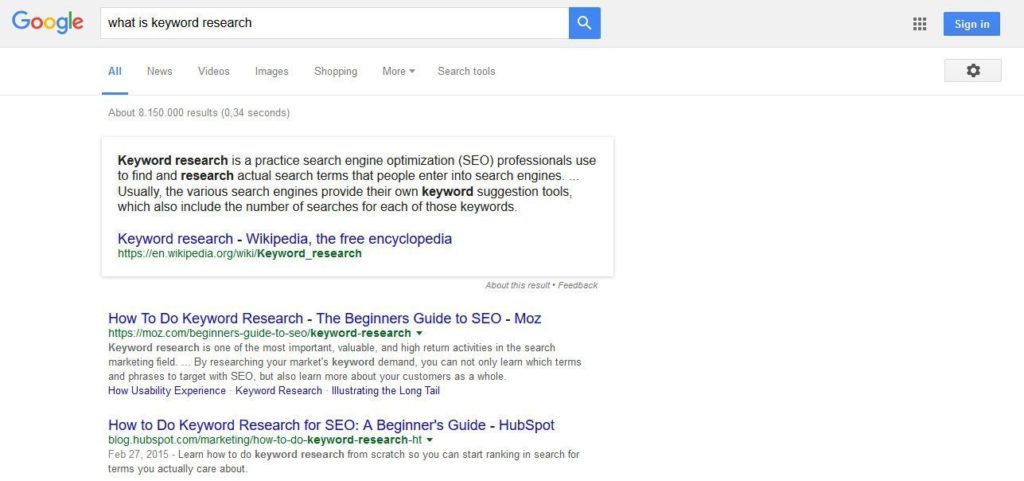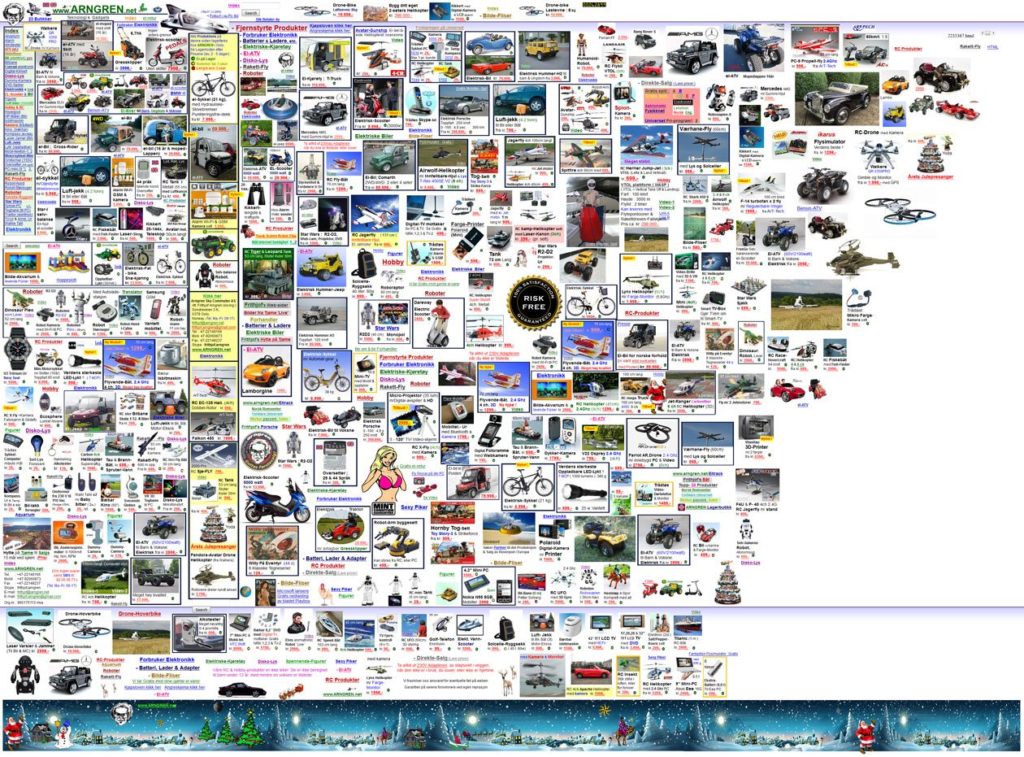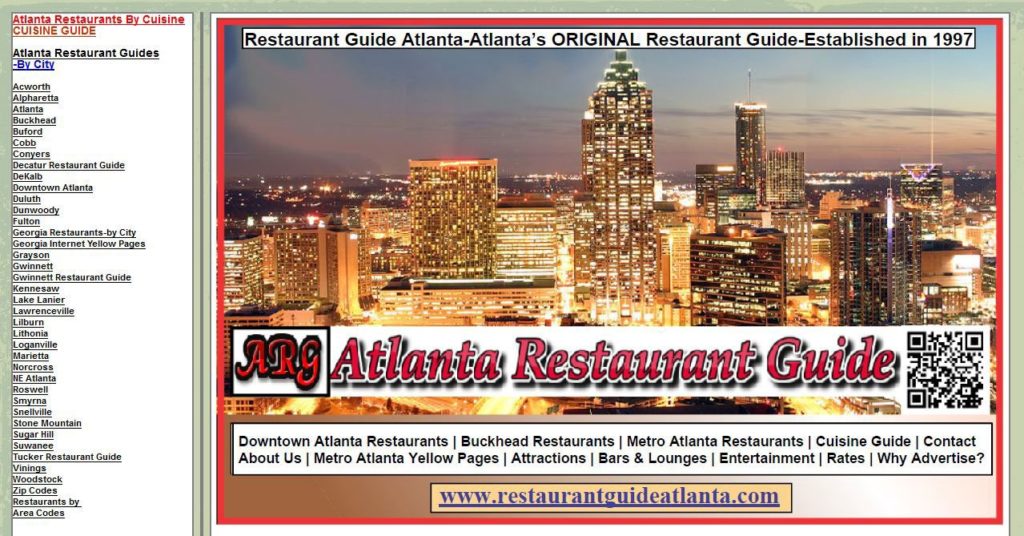The post 10 Effective Strategies to Come up With Content Ideas for Your Blog appeared first on Torque.
]]>Feeling stuck in writer’s block is not a lot of fun. For that reason, in this post we want to show you how you can get out of it. In the following, we will go over some tried-and-true strategies to consistently come up with new content ideas. This will prevent you from ever again having to look at a blinking cursor with no clue what to write.
How to Easily Generate Blog Content Ideas
There are many ways to come up with content ideas. Some of them will work for you, some of them won’t. Just go through the list below and find what fits your workflow and take it from there.
1. Create Topics in Batches
When you sit down to write, coming up with a topic shouldn’t be the first thing you do. Instead, at that point, your topic should already be clear and you should be ready to flesh it out.
A good way to make that happen is to create many topics at once. If you are already in the process of researching topic ideas, it’s easier to just keep going. After all, batching similar activities is an effective productivity tip.
So, just continue for a few hours until you have enough topics for a couple of weeks. That way, you always have a list of potential articles at hand and can just start hammering one out.
2. Check Your Analytics
Tools like Google Analytics and Search Console should always be part of your SEO efforts. They can tell you a lot about how your audience finds your site, what they like about it and how they interact with it. For example, looking at the most frequented pages will give you a good idea about their content priorities.

However, one of the most important parts is the Search Analytics section in Google Search Console. It is located under Search Traffic and tells you which search queries you are already ranking for, even if just tangibly.
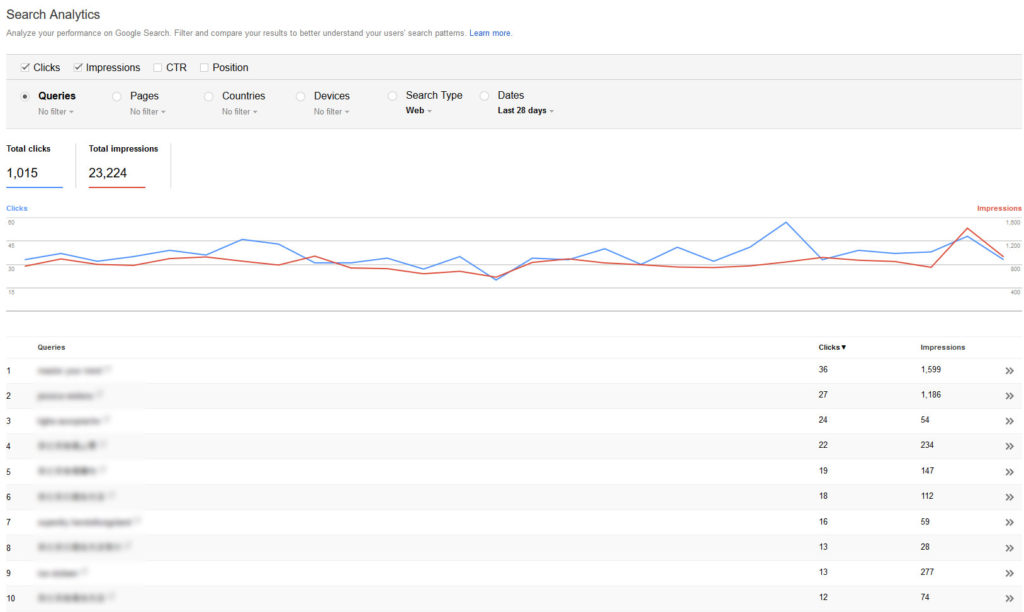
This is very useful intel and from here you should be able to come up with more than a handful of ideas for new blog posts. It also makes sense to check back regularly as the search terms will change the more content you publish on your site.
3. Research Social Media
Social media is another good place to source content ideas and you can do so in many ways:
- Audit your audience — For additional content ideas, see what your audience is interested in. You can do so by checking what they publish and which other people they follow and interact with. Alternatively, talk to them directly. Ask what they are currently struggling with, what they are into at the moment or some concrete questions about different topics.
- Take part in Facebook Groups — By joining groups in your topical area (or even founding your own), you can find a lot of potential topic ideas. Follow the discussions to see what people are struggling with, which questions they have etc. That way, you can find a lot of problems to solve for your audience, which is always a great basis for a blog post.
- Check Twitter — Tweets offer lots of information about what people in your niche are thinking about. Plus, the platform is easily searchable. Even better, you can subscribe to important hashtags and search terms via Tweetdeck. That way, you have a live feed of people’s thoughts and can even filter them by engagement and other factors.
- Hang out on Quora — This is literally a platform based on people asking questions. Just search for any keyword or topic idea and you will find plenty of things your audience seeks help with. This will give you lots of input for what to cover on your site.
Of course, there are many more platforms out there that you can mine for content ideas such as Reddit, LinkedIn, and Pinterest. For more ideas, check this article.
4. Read Blog Comments
Blog comments are one of the best sources of new content ideas. Oftentimes, people will tell you directly what they would like to hear more about – a gold mine for new blog posts.
So, not only should you answer every comment but also take note of what commenters are saying. Sometimes you can use their questions directly as blog post titles. Remember, people type the same stuff into Google, so these are basically key phrases you can base entire articles on.
However, don’t just concentrate on your own comment section. Frequent other blogs in your industry and see what readers say underneath their content. This will often point you to what is missing from your competitor’s articles. If you can fill in that gap, all the better for you and your authority.
5. Look at Your Competition
Talking about other websites in your sphere, those also a good source of inspiration. Checking what other people are writing about will give you heaps of content topic ideas and point out areas which you have neglected so far.
Better yet, input their blog address into BuzzSumo. This will show you which of their blog content is performing the best. That way, you can find proven content ideas.
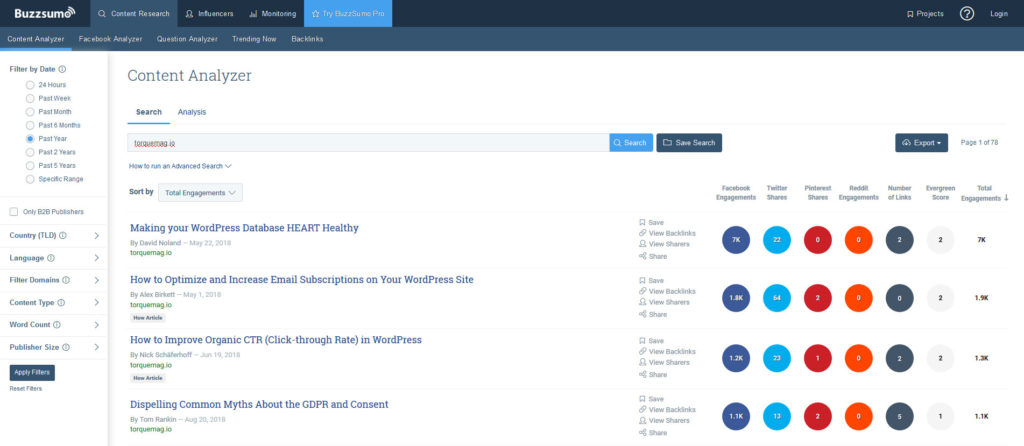
Knowledge like that is especially useful when combined with the Skyscraper Technique. The way it works is that you take well-performing content and make it even better. This can be by adding more information, making your post longer and more detailed, offering better design or any other way to create additional value. Doing so not only gives you some great content ideas, but it’s also an excellent way to get to the front page of Google.
6. Use Google Search Suggestions
Search suggestions are really helpful to go from general topic to concrete ideas. We already mentioned it in the article on keyword research. When you input anything into the Google search bar, it will automatically complete suggested related search phrases to you.

This already gives you concrete ideas about what users type into Google since these suggestions are based on actual searches.
You can combine that with related searches at the bottom of the SERPs.
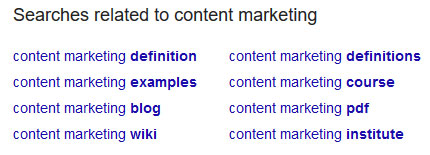
These are another valuable source of concrete key phrases as well as blog post titles. Plus, you already know that they are relevant to your audience, so ka-ching!
7. Use Tools
If you can’t come up with anything yourself, you may also get support from technology. There are a number of tools out there designed to help you generate content ideas.

- HubSpot Blog Ideas Generator — Enter up to five different keywords and the tool will spit out blog post titles for a whole week. However, by now the suggestions are quite limited and repetitive. For more, you need to sign up for their premium solution.
- Portent Content Idea Generator — Similar to the above. Enter a topic and the tool will put together a blog post title for you. Refresh to get additional ideas.
- Answer the Public — When you submit a keyword to this service, it will pull lots of data from Google about what people look for in connection with it. Especially useful are the questions that users type into the search box. However, the site also cycles through every letter of the alphabet in combination with your keyword to see what else people look for.
- Ubersuggest — Similar to AtP. Just input a topic/keyword and the tool will not only give you information about its number of searches and difficulty ranking for it, but you also get a long list of keyword ideas related to your input. From here, it’s much easier to come up with blog post topics.
For additional tools to come up with blog post ideas, check this post.
7. Share Personal Stories
Storytelling is one of the most effective ways to connect with your audience. There is nothing that we as humans can relate to as well as what happens to other people. Vulnerability is a great connector. So, if your content idea well has run dry, think about your life experience.
- Are there any interesting stories that happened to you that others could learn from?
- Lessons that are worth sharing?
- Mistakes you have made?
- Big wins you have experienced?
This will not only help you come up with new content ideas, but it’s a powerful way to tell your audience more about yourself. Plus, any story will be unique to you, so nobody else will have that content.
8. Mine YouTube Videos
YouTube is the second-largest search engine in the world. By now you can find information on literally anything on the platform. How is that helpful for you to find new content ideas? Because you can use it the same as Google and take advantage of its related search functions.
For one, when you start typing in a search phrase, here, too, you will get suggestions that can already function as concrete topic ideas.
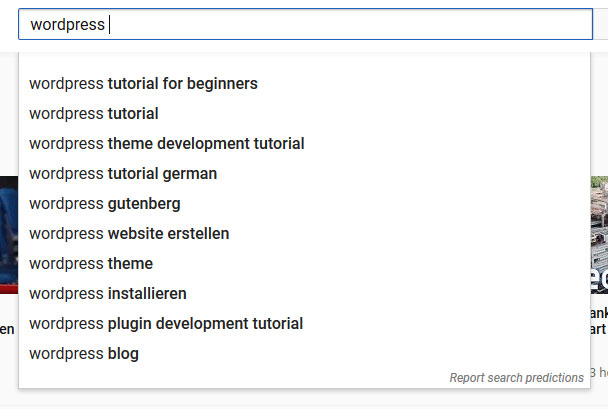
In addition to that, related videos pop up whenever you are watching something. These can give you ideas for additional content.
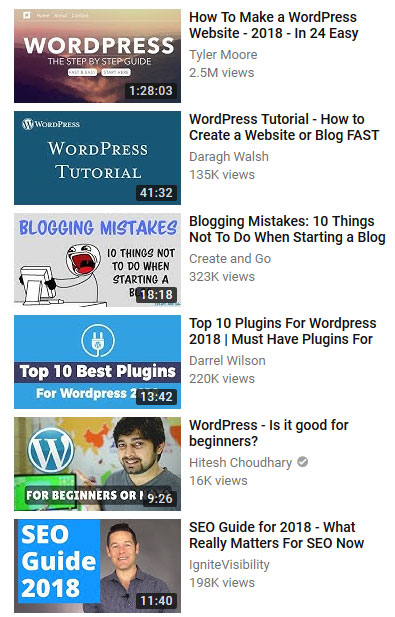
Plus, don’t forget to read through the comments. I know, I know, YouTube comments are literally the worst but there are also legitimate inquiries from users that help you understand what else they are interested in.
9. Cover New Developments in Your Industry
No matter what niche you are working in, there are always new developments worth covering. For example, these can be in the form of:
- new products
- emerging trends
- latest technology
- recent studies
Ideally, you should stay on top of these in order to keep informed. However, they can also be a great source of content material. You can tell your audience what these developments mean for them or how to best deal with recent changes. This gives you both something to share and makes you look like an authority if you do. A win-win situation.
10. Update Old Posts
Older content can also serve as a springboard to come up with new content ideas. This is especially true if a lot of time has passed and the information is no longer accurate.
I did that here on Torque. My first article ever was 4 Ways to Turn WordPress into a Multilingual Website. Then, when many things had changed after a few years, I wrote a similar article called 11 Best WordPress Translation Plugins For Multilingual Websites. I’m sure you can do similar things with your old posts.
However, instead of an update, you can also write supplemental content. For example, I could have used the old post to write about how to translate content most effectively so you can include it on your site with one of the translation plugins. So, keep that in mind when generating content ideas.
Conclusion
Writer’s block can happen to anyone. Not every day is an inspired day for writing. However, one of the best antidotes is to have a list of topic ideas already at hand. That way, you are ready to go at a moment’s notice.
To achieve that, above your have learned effective strategies to come up with fresh content ideas. These should be enough to keep your blog well populated. The key is to just put together a large list using good old-fashioned keyword research and market research. Then there are no excuses left.
What is your favorite way to come up with new content ideas? Let us know in the comments section below!
The post 10 Effective Strategies to Come up With Content Ideas for Your Blog appeared first on Torque.
]]>The post 43 of the Best WordPress Blogging Tools 2016 You Shouldn’t Miss appeared first on Torque.
]]>Blogging seems so simple from the outside. Just sit down in front of your WordPress website, type in some words, publish them and that’s it, right? After that, all you need to do is wait until your content gets picked up by Google and traffic comes in, correct?
Unfortunately no. People are often surprised to learn that writing is actually just one part of blogging and that a lot more goes into running a successful blog. For that reason, full-time bloggers can use all the help they can get.
Since WordPress is one of the primary blogging platforms out there, we decided to compile a list of the best WordPress blogging tools 2016 had to offer to help bloggers make the most out of their websites.
Sounds good? Then let’s get started.
How to Set Up a Blog
First on our list of blogging tools is, of course, WordPress itself. The platform is free and offers all the necessary functionality and features to build high-quality and high-traffic blogs. It is reliable, scalable, safe, and SEO optimized out of the box, plus there are many more benefits of using WordPress.
In case you are completely new to the WordPress game, here are a few articles to help you get started:
Alright, once you have your blog in place, it’s time to fill it with articles. Let’s move on to blogging tools that can help with that.
Blogging Tools for Content Generation
The following tools will help you come up with topics, create high-quality blog posts, spruce them up with visuals and much more.
Topic Generation
Coming up with topics to write about is often challenging. Luckily, there are plenty of tools out there to make it easier.
- Buzzsumo — This tool is on everyone’s list for topic creation. Type in any keyword and Buzzsumo will show you content around that topic that’s already proven to be successful. From there, it’s easy to create something better or related. Plus, the service can be used for competitor analysis to see which posts work best for other people.
- Feedly — Feedly is a slick RSS reader. It enables you to subscribe to other websites, create collections by topic and stay up to date on what they publish. The service will even let you know about the relative popularity of articles so you know which ones are most successful. Great in combination with Buzzsumo.
- Pocket — An awesome tool to save articles for later. Install its browser extension and, if you find an article you like, just click the button and add it to your collection. If you run out of topic ideas, check your account for loads of inspiration.
- Quora — Quora is a gold mine for new topics. It’s a community of people who ask and answer questions like in Yahoo Answers but the answers are actually useful. Just search for your topic and you will find many inquiries about it asked by real people. Great to understand your audience and find stuff to write about.
- AnswerThePublic — Talking about questions: That’s exactly what this blogging tool specializes in. Type in a keyword and AnswerThePublic will create hundreds of questions people pose to Google on that very topic. It will also mine the Google autocomplete function for additional keywords. Also, has a hilarious animation on the homepage.
- Google Adwords Keyword Planner — The classic tool to find keywords and topics. The Keyword Planner helps you find new and related keywords for anything you type in. It’s very useful to generate additional ideas. Plus, it can give you an indication of how popular your existing keyword ideas are, though not as precisely as it used to be.
- Hubspot Blog Topic Generator — The concept of this tool is simple: type in three keywords and it will create five ready-to-use headlines for you. All you need to do is copy and paste. Alternatively, repeat the process until something worth writing about pops up.
- IMPACT Blog Title Generator — Writer’s block? If so, this is the right tool for you. It not only gives you random topics to blog about but also creates title templates. If you like one, just hit the heart button to save it to your notebook. There’s even a Writer’s block? button that takes you to a mindmapping/doodle screen.
- SEOPressor Blog Title Generator — Another topic generation tool with a twist. Input your topic, pick whether it’s a person/event/product or other and hit Generate Titles. You’ll get five titles you can use right away or reload as often as needed for more.
Writing
Once you are settled on a topic, it’s time to get to the writing part. Some helpful tools for that are:
- Distraction-free writing mode — The DFWM is a feature built right into WordPress. It eliminates all unnecessary things from the writing experience so you can completely concentrate on creating a great piece of content. For further customizations of the distraction-free writing mode, check Just Writing.
- Transcribe — Interviews are an important staple of the blogging world, however, getting them on paper can be a pain. Enter Transcribe, a (paid) tool to transcribe audio files. The program lets you slow down, rewind or pause audio files to help you type out what you hear. Alternatively, use their dictation software for a hands-free experience.
Content Optimization
After you are done with the first draft, it’s time to improve it. Editing is actually the part where most of the work happens and that takes a piece from mediocre to great. Naturally, you shouldn’t skimp here and the tools below will help you make the most of it.
- CoSchedule Headline Analyzer — Besides their editorial calendar plugin, CoSchedule offers a free headline analyzer. Plug in your blog post title to receive an overall score, a breakdown of how well composed it is, tips for improvement, and even a preview of what it would look like in Google. Super useful.
- Emotional Marketing Value Headline Analyzer — Another headline analysis tool. This one specifically checks for emotional marketing value, meaning how well your title will appeal to people’s feelings. Doing so is key for conversions and more.
- Title Experiments — Still not sure about which headline to go with? Luckily, you can find out the most effective with this handy plugin. It lets you put in several headlines for the same article that are then randomly shown to visitors. Find out which gets the most clicks before making a choice for the final version.
- Grammarly — Errors in your content make you look unprofessional. Grammarly is a free grammar checking tool that can be added to your browser and will check anything you write online. The tool can find over 250 types of errors including word choice, grammar mistakes, and typos. An alternative is the Hemingway App.
- Readability Score — Besides grammatical correctness, readability is another important quality factor for online content. Want to know how readable your latest post is? Paste it into this tool and get your score on several readability scales, tips to improve the text quality, keyword density, and more.
- Yoast SEO — No optimization list would be complete without this plugin. Yoast SEO will not only optimize your WordPress site for search engines in general, it also has a content analysis section that tells you exactly how to improve your content’s on-page SEO. In addition to that, they recently added a readability check to improve your SEO copywriting.
Visuals
Visual content is much more appealing than pure text. However, not everyone has a graphic designer at hand to create awesome images. Thankfully, there are a lot of excellent blogging tools to help you out.
- Stencil — Stencil is an online image creation program. It offers thousands of backgrounds, icons, templates, logos and more to create stunning visuals and has image presets for all sorts of purposes and social networks. A free account lets you create 10 images per month.
- PicMonkey — Similar to Stencil, Picmonkey is an online tool for photo editing and touch up. It lets you make collages, offers templates and even a mobile app. A free 7-day trial is available.
- Evernote Web Clipper — People who write on technical topics (like yours truly) often need screenshots for their content. One of the best tools to create them is made by Evernote. Simply add it to your browser, click, add annotations and you are done. Another alternative is Awesome Screenshot.
- TinyPNG — Speed has become more and more important in web design over the years and visuals often make up the largest part of any web page. For that reason, it’s important that they are as small as possible. This tool allows you to do lossless compression for up to 20 images at once and there’s even a WordPress plugin that can perform the optimization automatically.
- Free stock photos — For those unwilling to pay for visuals, there are loads of options to find royalty-free photos with various licenses. Check out our article for more than 40 sources of free stock photos.
Blogging Tools for Marketing
Alright sparky, you now have everything start creating excellent content. After that, the next step is to get it in front of people. The following marketing tools will help you do so.
List Building
“The money is in the list” is what most successful online marketers will tell you. For that reason, don’t waste that hard-earned traffic and start building an email subscriber list from the beginning with these tools.
- MailChimp — Among all email marketing providers MailChimp is my personal favorite. Drag-and-drop template creation, their great branding voice and the fact that it’s free for the first 2000 subscribers are just a few of the reasons for that. If you sign up, don’t miss our guide on how to connect MailChimp to WordPress.
- SumoMe — SumoMe made quite an impression when it came out last year as a collection of apps for list building, image sharing, and much more. It’s highly recommended and you can read all about it in our in-depth article.
- OptinMonster — Similar to SumoMe, OptinMonster offers many different ways to collect email addresses. It comes with loads of form options, connects easily to all important email marketing providers, and is fully customizable. While it’s not free, it does have its own WordPress plugin to easily add forms to your website.
Web Analytics
Analytics are standard for most websites in order to optimize the site and see whether or not your strategy is working.
- Google Analytics — When it comes to web analytics, Google’s free suite is a popular choice. The good news for WordPressers: there are several plugins that easily connect them with your WordPress site (such as this one). Plus, don’t miss out on our beginner tutorial to find your way around.
- Jetpack — Jetpack by Automattic also comes with visitors stats. While not as extensive as Google’s version, it’s a great tool to gather an overall understanding of how your site is faring.
User Engagement
Marketing is not just what happens offsite, but also on the site itself. Comments are a sign of social proof and user engagement, so don’t neglect them.
- Postmatic — Hands down one of my favorite WordPress plugins that enables users to comment on your site via email. It means whenever someone comments on one of your posts, you are notified via email and can answer in the same way! Revolutionized my life.
- Yuzo Related Posts — Showing related posts is a great way to keep visitors on your site longer, however, plugins of this kind are infamous for being resource-hungry and slowing down websites. For that reason, this plugin was specifically designed to address this shortcoming. An alternative might also be Contextual Related Posts.
Social Media
While everyone is looking for love from Google, organic traffic is not everything. Millions of potential visitors can be found on social media networks and other alternative search engines. The tools below will help you make the most of them.
- Buffer — This service is like an online container full with social media updates that automatically get published according to your custom schedule and to channels of your choice. One of my favorite things in the world. We also have an in-depth guide.
- Hootsuite — Similar to Buffer, Hootsuite lets you publish content from a central dashboard. It also comes with analytics and more.
- NextScripts: Social Networks Auto-Poster — What’s easier than adding your content to social media management tools? Having it automatically published to your social networks once it hits the blog, of course! This plugin does exactly that. An alternative is Jetpack Publicize.
- TweetDis — Twitter lives off of one-liners, quotes, and other short content. TweetDis makes it easy to mark key points of your content, letting visitors publish them to the micro-blogging platform. You may also want to check out Better Click to Tweet.
- Pablo — Another tool by the people behind Buffer that helps you create social media images in minutes. Thousands of royalty-free stock images, many editing options, preset sizes for different platforms — it’s all there.
Other Blogging Tools
Finally, we have a number of excellent blogging tools for miscellaneous purposes.
- Evernote — We already mentioned their web clipper earlier, yet Evernote’s core product is a software to store articles, ideas, notes, and any other information you don’t want to forget. It also syncs automatically across different devices for access from anywhere.
- Trello — Trello comes in handy in case you are working with other people. It’s a board-based organizational system that helps you keep track of projects and collaborate with others.
- Toggl — A cool online time-tracking software. Helps you know exactly how you are spending your time, what’s your hourly pay and more. An alternative that counts time backwards is Eggtimer.
- Coffitivity — For those who want the feeling of working from a coffee shop there is this little website. Plug in your headphones, choose the atmosphere you are going for and have coffee shop ambiance as white noise while you blog away.
What Are Your Best WordPress Blogging Tools 2016?
Blogging tools are very helpful for anyone serious about running a successful blog and the search for the best blogging tools 2016 wasn’t an easy one.
Professional bloggers will find familiar faces in the list above but also a lot of new additions. Whether you are just starting out, looking for help with content creation, marketing or just looking for some productivity tool to help move you forward, you can find it here.
However, tools are only good if they are actually used. A whole toolbox won’t help you if you don’t put in the work. So, go out there and create some awesome content.
What are your best blogging tools 2016? Anything to add to the list above? Please do so in the comment section below!
The post 43 of the Best WordPress Blogging Tools 2016 You Shouldn’t Miss appeared first on Torque.
]]>The post WordPress SEO 101: How To Find The Right Keywords For Your Site appeared first on Torque.
]]>If you have read our in-depth guide to Yoast SEO you might even fill in the SEO title and meta description, pick a focus keyword, and follow the optimization tips on screen. That’s a good start. However, while SEO plugins can help you optimize your content for a particular keyword, they can’t tell you which keywords to target in the first place.
That’s where a lot of people get stumped. What is the best keyword to target? And how can you find the right keywords for your website?
The answer: keyword research.
Keyword research is an integral part of SEO and something that is often misunderstood, especially by newbies. For that reason, in the following, we will tell you all you need to know about how to research keywords. We will explain what exactly keywords are and why they matter, how keyword research works, and what a step-by-step approach to finding the best keywords for your site looks like.
Ready for some WordPress SEO 101? Then, by all means, keep reading.
What Are Keywords And Why Do They Matter?
To better understand what we are talking about, let’s have a look at what keywords actually are. If you understand that, it gets much easier to find the right ones.
Keywords Aren’t Magic
Many people are under the impression that keywords are some secret ingredient that, if added to their articles and pages, will instantly catapult them to the top of Google.
Many years ago that was sort of true. People all over the web tried to cram as many keywords in their web pages as possible so they could to get to Google’s pole position.
However, this has nothing to do with modern SEO. Today’s mechanisms for ranking websites are much more complex. Search engines understand better how to provide searchers with the results they are looking for and how to recognize quality content over spam. As a consequence, outdated practices like keyword stuffing will now get you penalized.
Overall, the importance of keywords has decreased over time. However, they still matter very much as you will see. If they are not some crazy secret ingredient only open to a chosen few, what are they?
Keywords Are Simply Search Terms
As it turns out, keywords are nothing very special. They are merely the terms that users type into search engines in order to find the information, products, or services they are looking for.
As already mentioned, search engines try to deliver the best results for their search. How do they judge that? In Google’s case by weighing 200 different ranking factors.
Within those, keywords play a very central role. It’s important not only to include keywords in your text, but also be aware of where you’re placing them.
For example, it makes a difference whether keywords appear in the middle of an article or as part of its title. Within the title, it also matters if a keyword appears in the beginning or toward the end.
For more details on this very complex topic check our article on WordPress on-page SEO.
There Are Different Kinds Of Keywords
It’s also important to note that not all keywords are created equal. They are usually divided into different categories depending on their search volume, competition, and difficulty to rank for them.
These categories are head, body, and long-tail keywords. I will explain what they are in a second, but first have a look at this infographic:
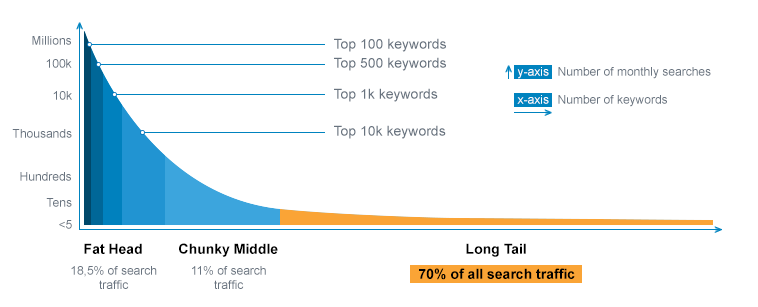
Head keywords are usually single-word keywords like “fitness.” As you can see above, they get the majority of search traffic but are also very competitive. That makes them very hard to rank for.
However, because head keywords are so unspecific, it doesn’t make sense to try to compete for them. In our example, someone searching for “fitness” could be looking for a gym, workout equipment, the meaning of the word fitness, or dozens of other things. For that reason, the conversion rate of head keywords is usually not very good.
Body keywords, on the other hand, are more specific as they are usually two to three words long. Think “fitness tips” or “fitness for women.”
This type of keyword most often has decent traffic and is easier to rank for than head keywords. However, depending on the industry, body keywords can still be very competitive.
The last on the list are long-tail keywords. Those are search phrases with four or more words that look for very specific information. To continue our example, something like “best fitness tips to lose weight for women” is a long-tail keyword.
While individually these keywords don’t bring in too much traffic, combined they make up the majority of all online searches, as you can see in the infographic above. Long-tail keywords are also infinitely easier to rank for and generally have a high conversion rate.
Which Type of Keyword Should You Try To Rank For?
That leaves the question which type of keyword is the best to target? Should you go for head, body, or long-tail keywords?
As already mentioned, head keywords are too unspecific and too competitive for most website owners.
Body keywords, on the other hand, have a nice combination of decent search volume, manageable competition, and good conversion rates. Therefore, it is generally a good idea to try and optimize your content for these keywords.
However, at the same time, it’s important to keep your eyes on long-tail keywords as you can usually also rank for related longer key phrases by sprinkling them in your content. For that reason, long-tail keywords should definitely be part of your keyword strategy and you should take them into account while doing keyword research.
So, let’s talk about that next, shall we?
What Is Keyword Research?
In a nutshell, keyword research is the process of finding the right keywords for your site. That means keywords and key phrases your audience is actively looking for in search engines.
Sounds simple, right? Yet, the significance of keyword research should not be underestimated. It is one of the most important, valuable activities you can do. Without it, there is no SEO.
Keyword research determines the structure of your site, the pages you create for it, and the type of content you publish.
Using the right keywords directly correlates with your standings in search engines and thus with your website traffic, sales, and leads.
Plus, keyword research allows you to learn more about your audience. As you will quickly find out, people write their innermost thoughts into the Google search box.
If you can learn more about those, you can understand your audience on a very deep level. That way you are able to address their fears, hopes, dreams, earn their trust and turn them into subscribers, clients and buyers.
It’s no coincidence that keyword research is an important part of market research for websites. Here is how it works step by step.
How To Find The Right Keywords For SEO
When it comes to keyword research, many people go straight to Google’s Keyword Planner. While that’s commendable, there are a few steps before that.
Why? Because while the Keyword Planner can give you very closely related keyword ideas (for example, “fitness tips for women” when you input “fitness tips”), it leaves out a whole lot of keywords that are topically related but don’t contain your seed keyword.
For that reason, it’s better to do some preparation first.
1. Brainstorm
While we will talk a lot about keyword research tools further below, any tool is limited by what you feed it. Therefore, it’s important that you do some thinking first before blindly using any of them.
It’s also important that you yourself are clear about the direction you want to take your keyword research. For that reason, as a first step, get out pen and paper or your favorite word processor and work through the following questions:
- Define Your Site’s Mission — To find the right keywords for your site, you first need to know what its goal or mission is. What are you promising readers? Which questions does your content answer? Knowing this is important so you can define initial keywords and search terms. It’s also important for you to be clear about it. Many website owners struggle with this for good reason.
- Create Marketing Personas — After defining your mission, it’s time to look at your audience. A good way to do so is to create fictional profiles of your ideal customers or readers. That way you can begin to understand them on a very personal level and see the world through their eyes. Check our article on how to do market research for websites for detailed instructions on how to create buyer personas.
- Brainstorm Related Industries — Especially for content marketing and blogging, thinking about secondary markets and industries your site touches on can give you loads of additional keyword ideas. For example, someone who is interested in fitness might also look for “weight loss tips,” “healthy recipes,” or “workout equipment.” Great stuff to attract additional visitors and something keyword research tools often can’t tell you about.
- Make a List of Seed Keywords — Finally, create a list of starter keywords from the above. Write down as many search terms as possible that you think your site has to offer.
Once you are done with this part of the process, we can get to everyone’s favorite part: keyword research tools.
2. Use Keyword Research Tools
With our list of seed keywords in hand, we can now go about and expand on them. At this point, it’s a good idea to input your keywords into a spreadsheet as you will soon have a lot of them thanks to the tools below. Let’s start off with the basics:
- Google Adwords Keyword Planner — This tool is the first stop for most users. It helps you find new and related keywords and is quite useful in coming up with additional ideas. Use these detailed instructions if you don’t know how to use it. The only drawback is the Keyword Planner is not very suitable to find topically related keywords.
- Google Trends — Great tool to compare traffic for different sets of keywords, check their popularity in different geographical regions, and the seasonality of certain keywords. Yet, the most important thing Google Trends can tell you is whether interest for your keywords is growing or waning. It will also give you searches related to your keyword.
- Google Search Console — Formerly known as Google Webmaster Tools, with this tool you can find out search terms you’re appearing for but for which you aren’t ranking well. Check Search Traffic > Search Analytics for missed opportunities. The tool will also tell you the pages in question so you know where to add unused search terms.
- Google Related Searches — When searching for anything in Google, you will find related search queries at the bottom of the screen. These are a gold mine for long-tail keywords, but also for additional keyword ideas.
Besides the basics above, we have the following additional keyword research tools. Many of them are especially suitable to find long-tail keywords.
- Keywordtool.io — Use of this tool is free for the basic functions, which are usually more than enough. It scrapes results from Google Suggest (the search suggestions that show up when you start typing something into Google) and adds characters before and after your seed keyword for a heap of search terms. Don’t forget to click on the Questions tab!
- Yoast Google Suggest Expander — Team Yoast have a similar keyword suggestions tool that is also mining Google Suggest. You can enter a seed keyword and it will show you hundreds of ideas that people are actually inputting into the Google search box.
- Soovle — Another free tool. Type in any keyword and it will deliver suggested search queries from platforms like Amazon, Wikipedia, Ask.com, Google suggest, YouTube, and more.
- Quora — Not really a tool but a Q&A platform like Yahoo Answers (but helpful). The site is a great place to find questions related to your keyword. It can give you loads of new topic ideas and blog post titles.
- Forums and Discussion Boards — Just search for “your industry + forum” to find places where people are discussing your site’s topic. Great way to know the kind of questions users have around your niche or product. Instead of “forum” you can also search for “board.”
Overwhelmed yet? Don’t worry, that’s normal. At this point, you should have more keywords in your file than you know what to do with. But you won’t have to optimize your site for all of them. Next, we will show you how to sort through the heap and find just the right keywords for your website.
3. Evaluate Commercial Intent
The most obvious answer to the question which keywords to pick from your list is to use the ones with the highest search volume. After all, we are after website traffic, aren’t we?
However, traffic isn’t everything. Instead, targeted traffic is what you should be shooting for.
The thing is, most of the time, we don’t want people to just make a flyby on our site, have a quick look and leave again. Instead, we want them to take some sort of action. Jump on our email list, make a purchase, you name it.
The best way to judge the likelihood of them doing so is to look at the commercial intent behind the keywords they are using. Commercial intent means the readiness for someone to make a purchase.
This not only influences our conversion rate (the number of people who take the desired action on our site) but also click through. For that reason, we want to find keywords with high commercial intent.
To accomplish this, we can divide our keywords into several categories:
- Buy now keywords — These include words like “buy,” “coupon,” and “discount”. Buy now keywords are used by people who are ready to get their wallet out and make a purchase.
- Product keywords — Are key phrases that search for product reviews or specific products. Users who use product keywords usually already have something on their mind and are looking for additional information before buying.
- Informational keywords — These are your usual “how to…” “best XYZ” queries that look for comparisons or a broad overview. These users are usually earlier in the buy cycle.
- Tire kicker keywords — Queries looking for “free” or “download.” Mostly just window shoppers who are collecting information for a potential purchase in the future.
For the highest commercial intent, look for buy now and product keywords.
At the same time, don’t completely disregard informational keywords. How to articles are a staple of the blogging world and great content so don’t throw them out just yet.
However, you can mostly disregard tire kickers as these people are very unlikely to convert.
If you are not entirely sure how to judge the commercial intent of your keywords, there are two additional indicators that make it very simple:
- Adwords Suggested Bid — Besides keyword ideas, the Google Keyword Planner can also tell you the average cost per click for each keyword if you were to post ads for it on Google. The higher the suggested bid, the more likely you will be able to convert organic traffic from this keyword into sales and signups.
- Adwords Competition — In the same place as the suggested bid, you can also see the competition for a particular search term in Adwords. The more people bid, the higher it will be. You can also get a feel for the competition by searching for your intended keyword and looking at the number of ads in Google.
Thinned out your list of keywords a bit? Good. Now let’s do it some more.
4. Evaluate The Competition
After finding a number of worthwhile keywords with high commercial intent, it’s time to look at the competition. After all, if a keyword is popular and commercially viable, chances are good that someone else is also trying to rank for it.
That doesn’t mean you should only try to rank for keywords with no competition, as those are hard to find. In many cases, you can still get to the top by outcompeting other contenders. However, sometimes the effort isn’t worth it and you are better off targeting a different keyword that is less fought over.
To analyze the competition, we will look at the sites that pop up on the first page of Google, because who sets out to rank anywhere less than that?
There are some very technical ways to judge the competition and we will get into them below. However, if you don’t want to go so deep, a good rule of thumb is to look at the results and evaluate whether or not you think you could create something better than the pages already ranking in the top 10.
For example, if the first few results are a couple of very shallow blog posts and you think you could do better with an in-depth piece of content, go ahead!
Another good sign is if the results are riddled with pages from Yahoo Answers, Ebay, WordPress.com, Blogger, Ehow, and the like. In that case, you have a good chance to rise to the top with a well-optimized, high-quality, and dedicated web page.
Those who want to get more technical might want to install the SEOQuake and Mozbar browser extensions. Both will show you loads of data in the search results that you can use to size up your competition.
In particular, you want to look at the following:
- PageRank — The authority of a web page assigned by Google. Pages low in PageRank are ready to be knocked off their place on the front page. If you find a lot of them for your keyword, you are on to something. Moz’s Page Authority is a good complementary data point for this.
- Referring Domains — This is a number of domains that have linked to a particular page. The more people link to a page, the more authority it has in Google’s eyes. Be aware that you might have to gather more links (of the same quality) to beat other pages in the search results.
- Domain Authority — Some pages rank well just because they are part of a powerful domain. One of the best examples for this is Wikipedia whose articles often dominate the search results. Pages with a high domain authority are generally very hard to beat.
- Backlinks — It’s not only important how many backlinks a page has but also where they come from. Sites with loads of spammy backlinks are easier to beat than those with links from highly authoritative pages.
Done? Congratulations, you just did your first round of keyword research!
The list you have ended up with should be full of relevant, commercially viable, and attainable keywords ready to be implemented on your site.
Now it’s up to you to start creating content. If you need a little help with that, be sure to check our article on SEO Copywriting.
Find The Right Keywords For SEO
Keyword research is an essential part of SEO work. It enables you to find the right keywords for your site that will allow you to rank high for relevant searches and attract targeted traffic.
Keyword research is neither a secret weapon nor overly complicated. Know your site’s goal and audience, brainstorm possible search terms, enhance the list with keyword research tools and sort them by commercial intent and competitiveness.
Don’t worry if you are struggling in the beginning, there is a learning curve and you will get better over time. Keyword research is not a one-time thing but something that should be done repeatedly. The focus of your site might change, you will have additional ideas to market yourself, and new trends will emerge that you can profit from. Therefore, you will have additional chances to improve and refine your keyword research chops.
Don’t worry if things don’t go optimally the first time, you are infinitely better prepared to hit the front page than with the trial-and-error approach that loads of other people rely on.
What’s your approach to keyword research? How do you find the best keywords for your site? Let us know in the comment section below.
The post WordPress SEO 101: How To Find The Right Keywords For Your Site appeared first on Torque.
]]>The post 9 Common Web Design Mistakes (And How to Avoid Them) appeared first on Torque.
]]>What to do?
In that situation, most people would look at their content, SEO, or marketing strategy. However, another piece of the puzzle that is just as important but often neglected is your site’s web design.
Website design mistakes can hurt your efforts. To avoid that situation, in today’s post we will not only have a look at why web design matters but also go over nine common web design blunders and how to avoid them.
Ready to overhaul your site design? Then let’s wait no longer.
The Importance Of Good Web Design
Before we get to our examples of ineffective web design, let’s first look at why investing in good web design is important in the first place.
First Impressions Matter
You know how they say that you never get a second chance to make a first impression? That sentiment is also true for websites.
Visitors decide very quickly whether or not to stay on your site. Therefore, you want to make sure your first impression is as positive and clear as possible. Whoever comes to your site should quickly be able to figure out what it is about and what they can do there. Otherwise, your visitors are out of there quicker than you can google “high bounce rate effect on search rankings” (hint: it’s not a good one).
Plus, once visitors have formed an unfavorable opinion of your site, they are less likely to return.
Quality Web Design Builds Trust
How quickly do visitors form a first impression from your design? Well before they get to the first line of content. That means they have already made a decision about whether or not they can trust your information before they have read it. I know, crazy right?
However, it only underscores the importance of proper web design, especially in industries like health and medicine where trust matters most. It also extends to other business areas as well. So, if you want your visitors to stick around, make sure the face you turn to them is a trustworthy one.
Web Design Provides Guidance
Most of us run websites not merely to show off or for the heck of it but because we have a goal in mind. It may be getting people to join on our email list, buy our product or something else.
This is another area where web design plays an instrumental role because it provides guidance. Good design will move visitors along to the desired destination, bad design will leave them clueless as to what they are supposed to do on your site.
Web Design = Aesthetics + Usability
Web design is not just about how your site looks but also about how users interact with it. In fact, it influences everything else.
Take loading speed and search engine optimization for example. If your site is filled with large images and needs to load five custom fonts in order to render, it will be considerably slower. Not only does this have an impact on your visitor bounce rate but it will influence your site’s search rankings.
Because of that, web design lies at the basis of the overall success (or lack thereof) of any WordPress website. That’s why the next part of this article deals with how you can make sure it does a good job.
9 Web Design Mistakes To Avoid (And Their Solutions)
Ok, now that we know the overall importance of quality web design, let’s look at a number of examples for how not to do it and alternative strategies.
A Slow-Loading Website

We have already mentioned the importance of web design for site speed.
While it can be nice to have a lot of fancy JavaScript animations, the latest technology and gimmicks on your site, if it comes at the cost of performance, it won’t do you much good. In that case, a large number of people might not even see your website design since they won’t wait for it to be done loading.
Not good.
What to Do Instead
- Treat performance as part of design — We already mentioned in the beginning that web design is not only looks but also usability. In fact, visitor’s think that a website’s performance is it’s most important marker of quality so plan your performance budget accordingly. We also have an entire article on how to speed up WordPress.
Too Much Clutter And Inconsistent Web Design
As in many things in life, less is more is an important rule in web design. The goal of good design is to provide guidance, focus, and a content hierarchy. A page that is cluttered with dozens of elements vying for the attention of the viewer is exactly the opposite.
According to Hubspot, 76% of users value usability over fancy design. Therefore, when visitors don’t know what to click on or look at, your web design has effectively failed and you have lost a visitor to the competition.
The same applies to pop-ups, presentations, videos and other hoops visitors have to jump through before getting to the actual content. If the effort is too great they might simply decide it’s not worth it and leave.
What to Do Instead
- Keep it simple — Rather than thinking about what you can add to your site, consider what can be eliminated. Define the goal of each page and check every element for whether it adds to the achievement of that goal.
- Stay consistent — Avoid sudden changes in color scheme, layout, or sidebar positions. While variation is possible and encouraged to some degree, people should not feel like they went to another website when merely changing a page. Consistency is also important for your branding.
- Leave lots of space — Sufficient whitespace around design elements is also important. It lets the design breathe, guides user focus and creates relations and a hierarchy between elements.
- Divide content — Should you cover many different topics on your site, don’t cram them all in one place. Give each their own section in the form of subpages or archives, group related pages by topics and eliminate what’s not necessary.
Large, Uninterrupted Blocks Of Text
Most visitors today are looking to scan content quickly to get an overview and decide whether or not to read it in its entirety. Having one big chunk of text will make that difficult.
Websites aren’t books and should therefore not come with the same layout. It’s hard to read, offers no rest for the eyes, and immediately makes your site look low quality. Even if the information you provide is literally worth gold, most visitors will not bother finding out.
What to Do Instead
- Use different fonts, font sizes, and colors — The first step in making the text more appealing is to give it some formatting. That means adding distinct design to links and other text elements that stand out as well as playing with font sizes and colors to make the visual experience more exciting.
- Add paragraphs — Secondly, it helps to break up large chunks of text into smaller paragraphs. This makes text easier to consume, adds space inside your content, and breathing room for the eyes. Quick tip: Be sure to include only one idea per paragraph. You can find more info in Team Yoast’s presentation on copywriting from WordCamp Europe 2016.
- Include headings — In addition to dividing your text into smaller parts, you can also create topical divisions by using WordPress headings. That way you can make the text scannable and give readers an overview without forcing them to read the entire content. Headings are also useful for on-page SEO.
- Use images and other elements — Also, nobody likes an all-text experience. For that reason supplement your design with visual elements. Images are a first choice here and there are lots of free stock photos available for this purpose. However, don’t forget about quotes, links and other elements that can break up text blocks.
Bad Calls To Action
As we said in the beginning, websites have a purpose and a goal they should move visitors toward. The epitome of this is the call to action, which is the focal point of most websites. However for some reason many make it too hard to find.
Often the call to action is hidden too far down the page or too unremarkable to notice. Or there are competing calls to action on one page so visitors get confused.
That’s not the goal at all. Instead, web design should enable visitors to understand easily what the objective of your site is and/or what they can get out of it.
What To Do Instead
- Display calls to action prominently — Getting to the CTA should not be a game of hide and seek. Instead, your CTA needs to be clearly visible and also specific. Don’t make visitors guess, tell them exactly what you would like them to do and what they will get in return.
- Make it easy to say yes — The more barriers you put up, the less likely visitors are to reach the end goal. Therefore, if you give them a form to fill out, only ask for the information you actually need such as a name and email for a newsletter sign-up. If you ask for more, you make it harder for them to say yes.
- Be careful with popups — Popups and other calls to action can be very effective, however, they are also a balancing act between being productive and annoying your readers. Tools like SumoMe provide a number of different and effective ways to show calls to action. Highly recommended!
Lack Of Responsive Design
Unless you have been living under a rock for the past few years, you will know that responsive design has become a de facto standard. Two out of three minutes online are now spent on mobile devices.
Considering that, it’s very surprising that 28 percent of new WordPress websites don’t choose a mobile responsive theme. Say what!?
When this figure was revealed at WordCamp Europe, it prompted a call from Matt Mullenweg to make responsiveness a requirement for all new themes. The reason is simple. Without responsive design, you are not only alienating a large number of users who don’t use a desktop computer to surf the web but also risk being penalized by Google.
Thus, if your web design is not yet adaptive, it’s time to make some changes.
What To Do Instead
- Make your site look good on all devices — There really is no excuse not to have a mobile-friendly website, especially if you are using WordPress. You can choose from a wide range of responsive themes and use plugins for mobile optimization. For the DIYers we even have instructions on how to make your existing theme responsive.
Out-of-Date Design
On the web, new trends come and go and you don’t have to jump on every train. In fact, you probably shouldn’t, at least not for the sake of it.
However, at the same time, it’s important to pay attention to things that become an expected standard. The aforementioned responsive design is such an example. If you completely disregard all modern developments, you risk having your site look completely out of date.
Visitors have a keen feeling for when your site is outmoded and will judge you for it. That’s especially true if you are a technology company or have another reason to be expected to keep up to date.
What To Do Instead
- Stay on top of things — As we said, you don’t have to be a feature chaser but it’s important to keep your finger on the pulse. Read relevant blogs, sign up to tech newsletters and compare your site to modern websites around the web. No need to overhaul your entire design every few months but make sure important things are incorporated.
All Gimmicks, No Substance
On the other hand, the opposite case to the above is just as bad. A website can also have all the latest tech and features (parallax scrolling, sliders, animations — you name it) but be otherwise empty.
Style isn’t everything. If your site lacks substance, visitors will figure it out quickly and turn to websites that might be less shiny but that can deliver what they need. Even if your content is ok, overdone features can be too distracting and ruin the user experience.
What to Do Instead
- Focus on content — Yes, this is an article about web design, however, the heart of any website is still the content. Even if you don’t have a blog. Design should only try to make things pretty around it and not be the main attraction. Keep the focus on the content whether that’s writing, products or something else.
Bad Site Navigation
The menu is the primary way for visitors to get around your site. For that reason, it’s important to keep it usable and easy to understand. WordPress gives us a great many options for that.
However, some people leave it to the CMS to take care of the navigation automatically by adding all top-level pages directly. The result: A cluttered menu that is difficult to navigate.
What to Do Instead
- Take advantage of WordPress’ options — Under Appearance > Menus you can change literally anything about your site’s menus. Make good use of all options to create a logical and hierarchical menu structure.
Missing Sharing Options
Social media networks have become alternative search engines that can bring in thousands of visitors. However, only if your content actually gets spread on there.
You know what would make that easier? Sharing options, of course.
While some people will go through the effort of copying and pasting your site link to their favorite social network manually, most prefer a simple button click. Neglecting to give them that option is a failure in your web design.
What To Do Instead
- Add sharing options in important locations — Not everyone will get the idea to spread your content all by themselves. For that reason, be sure to add buttons and calls to action to all important places (such as at the end of your posts) and make them prominent and easily reachable. There are plenty of plugins for this.
Which Web Design Fails Are You Guilty of?
Good web design is one of the main ingredients for the success of any website. It is the first thing visitors notice and responsible for building trust, providing guidance and increasing usability.
That also means that bad web design can make your site unappealing and hard to use. It’s a balancing act between aesthetics and functionality that is not always easy to master.
By looking at the web design mistakes above you can at least avoid some of the most obvious blunders. At the same time don’t forget to experiment because that’s half the fun.
What web design mistakes do you often see online? Which have you made yourself? Let us know in the comment section!
The post 9 Common Web Design Mistakes (And How to Avoid Them) appeared first on Torque.
]]>


